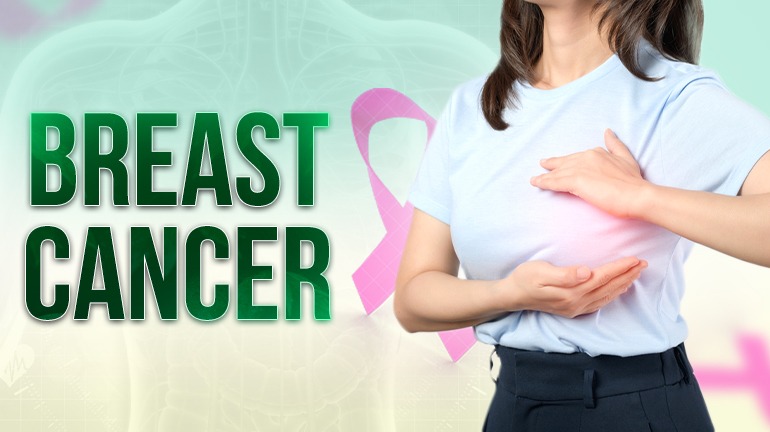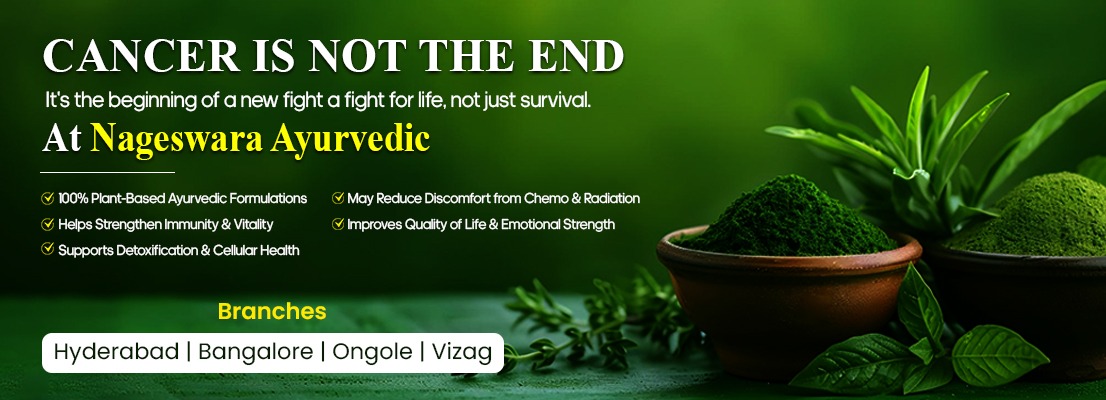
Breast Cancer
Breast cancer is a disease where cells in the breast begin to grow uncontrollably. These abnormal cells can form a lump or mass, and in advanced stages, they can invade nearby tissues or spread to distant parts of the body (metastasis).
- Lobules – glands that produce milk
- Ducts – tubes that carry milk to the nipple
- Connective Tissue – fibrous and fatty tissue that surrounds and supports the breast
Breast Structure
Most breast cancers begin either in the ducts (ductal carcinoma) or in the lobules (lobular carcinoma).
Causes of Breast Cancer
The exact cause is not fully understood, but breast cancer usually results from genetic mutations in breast cells. These mutations can be inherited or acquired during life due to various factors.
Main Causes:
- Genetic Mutations: BRCA1, BRCA2, and other genes
- Hormonal Factors: Prolonged exposure to estrogen (early periods, late menopause, hormone therapy)
- Lifestyle Factors: Obesity, alcohol, smoking, poor diet, lack of physical activity
- Environmental Factors: Radiation, carcinogenic chemicals, pollution
- Other Biological Causes: Weak immune system, oxidative stress, abnormal cell division
- Ductal Carcinoma in Situ (DCIS) – Abnormal cells are present but confined within ducts.
- Invasive Ductal Carcinoma (IDC) – Most common type, begins in ducts and spreads into breast tissue.
- Invasive Lobular Carcinoma (ILC) – Begins in lobules and spreads to surrounding tissues.
- Triple-Negative Breast Cancer (TNBC) – Lacks estrogen, progesterone, and HER2 receptors; aggressive and harder to treat.
- Triple-Negative Breast Cancer (TNBC) – Lacks estrogen, progesterone, and HER2 receptors; aggressive and harder to treat.
- Paget’s Disease of the Breast – Rare form affecting the nipple skin.
- Angiosarcoma – Cancer of blood or lymph vessels in the breast.
- Phyllodes Tumor – Rare tumor developing in connective tissue.
- Luminal A – Slow growing, best prognosis
- Luminal B – Faster growing, hormone positive
- HER2 Positive – Aggressive but responsive to targeted therap
- Basal-like / Triple Negative – Aggressive, limited treatment options
Types of Breast Cancer
Non-Invasive Breast Cancer
Invasive Breast Cancer
Special Types of Breast Cancer
Molecular Subtypes (based on receptors)
Risk Factors
Biological & Genetic
*Female gender (more than 99% of cases occur in women)
*Age (risk increases with age)
*Family history (mother, sister, or daughter with breast cancer)
*Inherited genetic mutations (BRCA1/BRCA2)
*Previous breast cancer or certain benign breast diseases
- Hormonal & Reproductive
- Lifestyle
- Environmental
- Free Radical Scavenging:
- Enhancing Antioxidant Defense:
- Anti-inflammatory Action:
- Immune Modulation:
- Neuroprotective & Cognitive Support:
- Anti-Tumor Potential:
- 1.Herbal Extracts after Purification
*Early menstruation (before age 12)
*Late menopause (after age 55)
*Having first child after 30 or never giving birth
*Hormone replacement therapy after menopause
*Obesity, especially after menopause
*Lack of physical activity
*Alcohol consumption
*Smoking
*Radiation exposure (especially at young age)
*Contact with carcinogenic chemicals
Signs & Symptoms
1.Lump in breast or underarm
2.Change in breast size, shape, or contour
3.Dimpling, puckering, or thickening of breast skin
4.Redness, scaling, or rash around the nipple or breast
5.Inverted nipple (turned inward)
6.Nipple discharge (may be clear, pus-like, or bloody)
7.Breast pain or tenderness
8.Swelling in part or all of the breast
Complications of Breast Cancer
1.Metastasis (Spread): To bones, liver, lungs, or brain
2.Recurrence: Cancer can return even after treatment
3.Treatment-related complications: Infertility, early menopause, side effects from chemotherapy/radiation
4.Emotional stress: Anxiety, depression, and reduced quality of life
5.Reduced survival: Early detection has high survival (>90%), but metastatic disease lowers survival to ~30% at 5 years
Ayurveda’s Perspective on Breast Cancer
Ayurvedic Understanding Breast Cancer is described in Ayurveda under the broad category of Arbuda (tumor).
Dosha involvement:
*Kapha Dosha → uncontrolled growth, heaviness, stiffness
*Pitta Dosha → inflammation, burning, rapid spread
*Vata Dosha → metastasis, pain, irregular growth
Imbalance of Rakta dhatu (blood tissue), Mamsa dhatu (muscle tissue), and Medo dhatu (fat tissue) play a key role.
Causative Factors in Ayurveda
Viruddhahara (incompatible foods – e.g., milk with fish, sour fruits with milk)
Ajirna (indigestion, weak Agni/digestive fire)
Ama (toxic buildup due to improper digestion & metabolism)
Stress, negative emotions, unresolved grief
Lack of proper regimen in diet, sleep, and lifestyle
Breast Cancer Treatment at Nageswara Ayurvedic – Role of Merremia quinquefolia
At Nageswara Ayurvedic, we focus on an integrated herbal approach to breast cancer care, where specific herbs are used to reduce oxidative stress, modulate immunity, and support anti-tumor activity. One such important herbal extracts is Merremia quinquefolia.
Modern research and Ayurvedic wisdom both highlight this herb’s unique properties:
Rich in phenolic compounds, Merremia quinquefolia helps neutralize free radicals, reducing oxidative stress – a key factor in cancer progression.
It improves the activity of natural antioxidant enzymes and supports glutathione levels, protecting healthy cells during chemotherapy and radiation.
By down-regulating pro-inflammatory cytokines, it helps reduce chronic inflammation, which is often linked with cancer growth and metastasis.
It stimulates helper T-cells and strengthens both innate and antigen-specific immune responses, improving the body’s natural defense against cancer cells.
The herb is also linked with increased acetylcholine activity, supporting mental clarity, memory, and cognitive health, which often decline during cancer treatment.
Laboratory studies have shown that Merremia quinquefolia extracts (especially in nanoparticle form) can inhibit cell proliferation, induce apoptosis (programmed cancer cell death), and prevent tumor progression.
Treatment at Nageswara Ayurvedic
At Nageswara Ayurvedic, we integrate the timeless wisdom of Ayurveda with modern plant-based innovations to provide comprehensive support in breast cancer management. Our approach focuses on safe purification, synergistic herbal formulations, adjunctive care, and Rasayana rejuvenation to promote healing, improve quality of life, and prevent recurrence.
In breast cancer care, Merremia quinquefolia is processed through advanced purification methods to remove heavy metals and plant-based toxic residues. This ensures a safe and bioactive extract that can be used effectively without side effects.
Neque porro est qui dolorem ipsum quia quaed inventore veritatis et quasi architecto beatae vitae dicta sunt explicabo. Aelltes port lacus quis enim var sed efficitur turpis gilla sed sit amet finibus eros. Lorem Ipsum is simply dummy text of the printing and typesetting industry. Lorem Ipsum has been the ndustry stan when an unknown printer took a galley.
